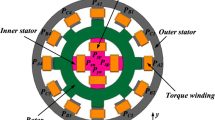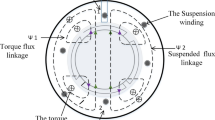Abstract
In this paper, the inductance characteristics of a 2-pole surface-mounted bearingless permanent magnet synchronous motor (BPMSM) with 4-pole suspension force windings are investigated based on theoretical analysis and experimental investigation. Firstly, the winding configuration and operation principle of the BPMSM are presented. Secondly, the static and incremental inductances are defined. Then, based on the finite element (FE) analysis method, the static inductances of torque windings and suspension force windings in stator static coordinate reference are researched. In addition, the d- and q-axes static inductances in rotor revolving coordinate reference are obtained by 3/2 Transformation. Furthermore, taking the torque windings as an example, the incremental inductance of torque windings is studied, and the validity of the theory is confirmed by comparing the static and incremental inductances. Finally, the experimental study is carried out to verify the discussed numerical analysis. The results are helpful to measure parameters and build the mathematic model of BPMSMs, and lay a foundation for the further research on BPMSMs.














Similar content being viewed by others
References
Ren Z, Stephens LS, Radun AV (2006) Improvements on winding flux models for a slotless self-bearing motor. IEEE Trans Magn 42(7):1838–1848
Yamada T, Nakano Y, Asama J, Chiba A, Fukao T, Hoshino T, Nakajima A (2008) Outer rotor consequent-pole bearingless motor with improved start-up characteristics. IEEE Trans Magn 44(11):4273–4276
Chiba A, Deido T, Fukao T (1994) An analysis of bearingless AC motors. IEEE Trans Energy Convers 9(1):61–68
Santisteban JA, Stephan RM (1999) Analysis and control of a loaded bearingless machine. IEEE Trans Magn 35(5):3998–4000
Khoo WKS, Kalita K, Garvey SD, Hill-Cottingham RJ, Rodger D, Eastham JF (2010) Active axial-magnetomotive force parallel-airgap serial flux magnetic bearings. IEEE Trans Magn 46(7):2596–2602
Fang J, Sun J, Liu H, Tang J (2010) A novel 3-DOF axial hybrid magnetic bearing. IEEE Trans Magn 46(12):4034–4045
Schneider T, Binder A (2007) Design and evaluation of a 60000 rpm permanent magnet bearingless high speed motor. In: Proceedings of 7th international conference on power electronics and drive systems, pp 1–8
Chiba A, Rahman MA, Fukao T (1991) Radial force in a bearingless reluctance motor. IEEE Trans Magn 27(2):786–790
Tera T, Yamauchi Y, Chiba A, Fukao T, Rahman MA (2006) Performances of bearingless and sensorless induction motor drive based on mutual inductances and rotor displacements estimation. IEEE Trans Ind Electron 53(1):187–194
Schneeberger T, Nussbaumer T, Kolar JW (2010) Magnetically levitated homopolar hollow-shaft motor. IEEE/ASME Trans Mechatron 15(1):97–107
Ooshima M, Takeuchi C (2011) Magnetic suspension performance of a bearingless brushless dc motor for small liquid pumps. IEEE Trans Ind Appl 47(1):72–78
Yang G, Deng Z, Cao X, Wang X (2008) Optimal winding arrangements of a bearingless switched reluctance motor. IEEE Trans Power Electron 23(6):3056–3066
Xia ZP, Zhu ZQ, Howe D (2004) Analytical magnetic field analysis of halbach magnetized permanent magnet machines. IEEE Trans Magn 40(4):1864–1872
Rosu M, Saitz J, Arkkio A (2005) Hysteresis model for finite-element analysis of permanent-magnet demagnetization in a large synchronous motor under a fault condition. IEEE Trans Magn 41(6):2118–2123
Zhang S, Luo FL (2009) Direct control of radial displacement for bearingless permanent magnet-type synchronous motors. IEEE Trans Ind Electron 56(2):542–552
Sun X, Zhu H, Pan W (2009) Decoupling control of bearingless permanent magnet-type synchronous motor using artificial neural networks-based inverse system method. Int J Model Identif Control 8(2):114–121
Sun X, Zhu H, Zhang T (2009) Sliding mode variable structure control for radial suspension forces of bearingless permanent magnet synchronous motor based on inverse system method. In: Proceedings of international conference on power electronics and motion control, Wuhan, China, pp 1848–1851
Zhu H, Cheng Q, Wang C (2009) Modeling of bearingless permanent magnet synchronous motor based on mechanical to electrical coordinates transformation. Sci China Ser E Tech Sci 52(12): 3736–3744
Bu W, Huang S, Wan S, Liu W (2009) General analytical models of inductance matrices of four-pole bearingless motors with two-pole controlling windings. IEEE Trans Magn 45(9):3316–3321
Xu Y, Torrey DA (2002) Study of the mutually coupled switched reluctance machine using the finite element-circuit coupled method. Proc IEEE Electr Power Appl 149:81–86
Ji J, Sun Y, Zhu H (2005) Magnetic field analysis of bearingless switched reluctance motor using finite element method. In: Proceedings of the 8th international conference on electrical machines and systems, Nanjing, China, September 2005, pp 2121–2123
Ren L, Cui R, Wang Z, Cheng Z (2000) Saturation effect of PMSM windings inductance. Trans. China Electrotech Soc 15(1):21–25
Bae BH, Sul SK, Kwon JH (2003) Implementation of sensorless vector control for super-high-speed PMSM of turbo-compressor. IEEE Trans Ind Appl 39(3):811–818
Krause PC (1986) Analysis of electric machinery. McGraw-Hill, New York
Nicklasson PJ, Ortega R, Espinosa-Perez G (1997) Passivity-based control of a class of Blondel–Park transformable electric machines. IEEE Trans Automat Control 42(5):629–647
Acknowledgments
The authors would like to thank the editors and the anonymous referees for their constructive comments and careful proof, which were helpful in the improvement of the manuscript. This work was supported by the National Natural Science Foundation of China under Project 61104016 and 51105177, the Natural Science Foundation of the Jiangsu Higher Education Institutions of China under Project 11KJB510002, the Specialized Research Fund for the Doctoral Program of Higher Education of China under Project 20113227120015, the Startup Foundation for Advanced Professional Talents of Jiangsu University under Project 12JDG057 and 11JDG047, and a Project Funded by the Priority Academic Program Development of Jiangsu Higher Education Institutions under Project 201106.
Author information
Authors and Affiliations
Corresponding author
Rights and permissions
About this article
Cite this article
Sun, X., Chen, L., Yang, Z. et al. Analysis of inductance characteristics for a bearingless permanent magnet synchronous motor. Electr Eng 95, 277–286 (2013). https://doi.org/10.1007/s00202-012-0262-6
Received:
Accepted:
Published:
Issue Date:
DOI: https://doi.org/10.1007/s00202-012-0262-6




